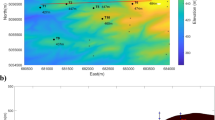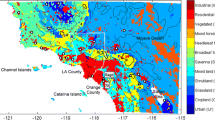Summary
A number of problems related to mesoscale numerical prediction of low stratus in the Alpine region are formulated, and addressed in a series of experiments for two wintertime cases. These problems include modelling aspects and issues of data assimilation which are relevant particularly in relation to the observation nudging technique. A focus is on the influence of orography.
A comparison of operational optimum interpolation, and nudging of routine rawinsonde and surface-level data reveals that nudging often yields better analyses and forecasts of low stratus, and notably of the sharp vertical temperature and humidity gradients. However, the humidity advection scheme of the model and, near steep terrain, particularly the horizontal diffusion along the model's σ-levels are identified to contribute to spurious vertical smoothing which can result in erroneous cloud dissipation. On occasions, forecasts succeeding a nudging period are more sensitive to this process due to the sharper initial vertical gradients.
Specific problems of representiveness arise when low-level rawinsonde information is spread laterally along the sloping σ-levels from low to high terrain. A new concept for σ-layer models is introduced by speading the observational information along isentropic surfaces, and this tends to improve the low stratus prediction over steep and even moderate orography. A partly successful attempt to take advantage of the steep Alpine orography is made by applying this concept to surface-level humidity data from a high-resolution network of Alpine surface stations which are distributed relatively uniformly in the vertical.
Similar content being viewed by others
References
Anthes, R. A., 1974: Data assimilation and initialization of hurricane prediction models.J. Atmos. Sci.,31, 702–719.
Atkins, M. J., 1974: The objective analysis of relative humidity.Tellus,26, 663–671.
Ballard, S. P., Golding, B. W., Smith, R. N. B., 1991: Mesoscale model experimental forecasts of the Haar of Northeast Scotland.Mon. Wea. Rev.,119, 2107–2123.
Ballard, S. P., Jackson, S. D., Macpherson, B., 1994: Short-range forecasting of stratocumulus: Initialization v. prediction. ECMWF Workshop Proc. on ‘Parameterization of the Cloud Topped Boundary Layer’, 8–11 June 1993, 403–429.
Bao, R. M., Errico, J.-w., 1994: Sensitivity of forecasts and analyses to the observations in FDDA using the dynamical relaxation (nudging) method. Proc. of 10th AMS Conf. on NWP, Portland, 584–585.
Bell, R. S., Hammon, O., 1989: The sensitivity of fine-mesh rainfall and cloud forecasts to the initial specification of humidity.Meteorol. Mag.,118, 152–158.
Benjamin, S. G., 1989: An isentropic meso-α-scale analysis system and its sensitivity to aircraft and surface observations.Mon. Wea. Rev.,117, 1586–1603.
Benjamin, S. G., Seaman, N. L., 1985: A simple scheme for objective analysis in curved flow.Mon. Wea. Rev.,113, 1184–1198.
Benjamin, S. G., Brewster, K. A., Brümmer, R., Jewitt, B. F., Schlatter, T. W., Smith, T. L., Stamus, P. A., 1991: An isentropic three-hourly data assimilation system using ACARS aircraft observations.Mon. Wea. Rev.,119, 888–906.
Benjamin, S. G., Kim, D., Schlatter, T. W., 1995: The Rapid Update Cycle: A new mesoscale assimilation system in hybrid (Θ — σ) coordinates at the National Meteorological Center. WMO/TD-No. 651. Proc. of ‘Second WMO International Symposium on Assimilation of Observations in Meterology and Oceanography’. Tokyo, 13–14 March 1995, Vol. I, 337–342.
Bergot, T., Guedalia, D., 1994: Numerical forecasting of radiation fog. Part I: Numerical model and sensitivity tests.Mon. Wea. Rev.,122, 1218–1230.
Binder, P., Schär, C. (eds.), 1995: Mesoscale Alpine Programme Design Proposal. Available from the Swiss Meteorological Institute.
Branscome, L. E., Douglas, D. A., Carpenter, R., 1994: Influence of drainage flows and surface processes on fog formation in a river valley. Proc. of 6th AMS Conf. on Mesoscale Processes, Portland, 560–561.
Brown, R., Roach, W. T., 1976: The physics of radiation fog: II-A numerical study.Quart. J. Roy. Meteor. Soc.,102, 335–354.
Buchhold, M., Paul, G., 1995: The regional and high-resolution data assimilation systems at the DWD. WMO/TD-No. 665, Research Activities in Atmospheric and Oceanic Modelling. CAS/JSC Working Group on Numerical Experimentation, Report No. 21, Ed. A. Staniforth, 1.10–1.11.
Clark, P., 1994: Case studies of fog in the UK Met Office mesoscale model. Proc. of 10th AMS Conf. on NWP, Portland, 15–17.
Courtier, P., 1994: Introduction to numerical weather prediction data assimilation methods. ECMWF Seminar Proc. on ‘Development in the Use of Statellite Data in Numerical Weather Prediction’, 6–10 Sept. 1993, 189–207.
Dastoor, A. P., 1994: Cloudiness parameterization and verification in a large-scale atmospheric model.Tellus,46A, 615–634.
Davies, H. C., 1976: A lateral boundary formulation for multilevel prediction models.Quant. J. Roy. Meteor. Soc.,102, 405–418.
Davies, H. C., Turner, R. E., 1977: Updating prediction models by dynamical relaxation: An examination of the technique.Quart. J. Roy. Meteor. Soc.,103, 225–245.
Eigenwillig, N., Ungewitter, G., 1993: Contributions to an improved forecasting of fog in Southern Germany. Proc. on 1st European Conf. on Applications of Meteorology, Oxford, 27, 9.–1.10. 1993.
Fast, J. D., 1995: Mesoscale modeling and four-dimensional data assimilation in areas of highly complex terrain.J. Appl. Meteor.,34, 2762–2782.
Golding, B. W., 1990: The Meteorological Office mesoscale model.Meteor. Mag.,119, 81–96.
Golding, B. W., 1993: A study of the influence of terrain on fog development.Mon. Wea. Rev.,121, 2529–2541.
Henmi, T., 1990: Assimilation of wind field over complex terrain. Proc. of 5th AMS Conf. on Mountain Meteorology, Boulder, 118–124.
Kvamstø, N. G., 1994: Cloudiness validation in the ECMWF model. ECMWF Workshop Proc. on ‘Parameterization of the Cloud Topped Boundary Layer’, 8–11 June 1993, 345–365.
Lanzinger, A., Steinacker, R., 1990: A fine mesh analysis scheme designed for mountainous terrain.Meteorol. Atmos. Phys.,43, 213–219.
Leidner, S. M., Stauffer, D. R., Seaman, N. L., 1994: Highresolution forecasting in the California coastal zone using four-dimensional data assimilation. Proc. of 10th AMS Conf. on NWP, Portland, 528–530.
Lorenc, A. C., 1981: A global three-dimensional niultuvariate statistical interpolation scheme.Mon. Wea. Rev. 109, 701–721.
Lorenc, A. C., Bell, R. S., Macpherson, B., 1991: The Meteorological Office analysis correction data assimilation scheme.Quart. J. Roy. Meteor. Soc.,117, 59–89.
Lorenc, A. C., Barker, D., Bell, R. S., Macpherson, B., Maycock, A. J., 1996: On the use of radiosonde humidity observations in mid-latitude NWP.Meteorol. Atmos. Phys.,60, 3–17.
Louis, J.-F., 1979: A parametric model of vertical eddy fluxes in the atmosphere.Bound.-Layer Meteor.,17, 187–202.
Macpherson, B., Wright, B. J., Hand, W. H., Maycock, A. J., 1996: The impact of MOPS moisture data in the U.K. Meteorological Office data assimilation scheme.Mon. Wea. Rev.,124, 1746–1766.
Majewski, D., 1985: Balanced initial and boundary values for a limited area model.Contrib. Atmos. Phys.,58, 147–159.
Majewski, D., 1991: The Europa-Model of the Deutscher Wetterdienst. ECMWF Seminar Proc. on ‘Numerical methods in atmospheric models’, Vol II, 9–13 Sept., 147–191.
Maycock, A. J., Macpherson, B., 1994: Developments in mesoscale data assimilation at the UK Met. Office. Proc. of 10th AMS Conf. on NWP, Portland, 561–563.
Mellor, G. L., Yamada, T., 1974: A hierarchy of turbulence closure models for planetary boundary layers.J. Atmos. Sci.,13, 1791–1806.
Miller, P. A., Benjamin, S. G., 1992: A system for the hourly assimilation of surface observations in mountainous and flat terrain.Mon. Wea. Rev.,120, 2342–2359.
Mills, G. A., Logan, L. W., 1994: Upgrades to the Australian limited area data assimilation system. Austral.Meteorol. Mag.,43, 167–180.
Musson-Genon, L., 1987: Numerical simulation of a fog event with a one-dimensional boundary layer model.Mon. Wea. Rev.,115, 592–607.
Pielke, R. A., Cotton, W. R., Walko, R. L., Tremback, C. J., Lyons, W. A., Grasso, L. D., Nicholls, M. E., Moran, M. D., Wesley, D. A., Lee, T. J., Copeland, J. H., 1992: A comprehensive meteorological modeling system — RAMS.Meteorol. Atmos. Phys.,49, 69–91.
Ritter, B., Geleyn, J.-F., 1992: A comprehensive radiation scheme for numerical weather prediction models with potential applications in climate simulations.Mon. Wea. Rev.,120, 303–325.
Roach, W. T., 1994: Back to basics: Fog: Part 1 — Definitions and basic physics.Weather,49, 411–415.
Roach, W. T., 1995: Back to basics: Fog: Part 2—The formation and dissipation of land fog.Weather,50, 7–11.
Roach, W. T., Brown, R., Caughey, S. J., Crease, B. A., Slingo, A., 1982: A field study of nocturnal stratocumulus: I. Mean structure and budgets.Quart. J. Roy. Meteor. Soc.,108, 103–123.
Schraff, C. H., 1996: Data assimilation and mesoscale weather prediction: A study with a forecast model for the Alpine region. PhD dissertation No. 11627, Federal Institute of Technology, Zürich. Available as ‘publication’ No. 56 from the Swiss Meteorological Institute.
Schrodin, R., (ed.) 1995:Dokumentation des EM/DM-Systems. Available from the Deutscher Wetterdientst, Research Dept.
Seaman, N. L., Stauffer, D. R., Lario-Gibbs, A. M., 1995: A multiscale four-dimensional data assimilation system applied in the San Joaquin Valley during SARMAP. Part I: Modeling design and basic performance characterisics.J. Appl. Meteor.,34, 1739–1761.
Shaw, D. B., Lönnberg, P., Hollingsworth, A., Undén, P., 1987: The 1984/1985 revisions of the ECMWF mass and wind field analysis.Quart. J. Roy. Meteor. Soc.,113, 553–566.
Spero, T. L., Seaman, N. L., Stauffer, D. R., 1994: Structureweighted observation nudging for dynamic initialization in the Penn State/NCAR mesoscale model. Proc. of 10th AMS Conf. on NWP, Portland, 575–577.
Staufer, D. R., Seaman, N. L., 1990: Use of four-dimensional data assimilation in a limited-area mesoscale model. Part I: Experiments with synoptic-scale data.Mon. Wea. Rev.,118, 1250–1277.
Stauffer, D. R., Seaman, N. L., Binkowski, F. S., 1991: Use of four-dimensional data assimilation in a limited-area mesoscale model. Part I: Effects of data assimilation within the planetary boundary layer.Mon. Wea. Rev.,119, 734–754.
Stauffer, D. R., Bao, J.-W., 1993: Optimal determination of nudging coefficients using the adjoint equants.Tellus,45A, 358–369.
Stauffer, D. R., Seaman, N. L., 1994: Multiscale four-dimensional data assimilation.J. Appl. Meteor.,33, 416–434.
Stensurd, D. J., Fritsch, J. M., 1994: Mesoscale convective systems in weakly forced large-scale environments. Part II: Generation of a mesoscale initial condition.Mon. Wea. Rev.,122, 2068–2083.
Temperton, C., 1988: Implicit normal mode initilization.Mon. Wea. Rev.,116, 1013–1031.
Vrhovec, T., 1990: Analysis of mesometeorological temperature fields.Meteorol. Atmos. Phys.,43, 235–240.
Wade, C. G., Schwartz, B., 1993: Radiosonde humidity observations near saturation. Proc. of 8th Symposium on Meteorological Observations and Instrumentation, Anaheim, 44–48.
Wang, W., Warner, T. T., 1988: Use of four-dimensional data assimilation by Newtonian relaxation and latent-heat forcing to improve a measoscale-model precipitation forecast: A case study.Mon. Wea. Rev.,116, 2593–2613.
Wanner, H., 1979:Zur Bildung, Verteilung und Vorhersage winterlicher Nebel im Querschnitt Jura-Alpen. Geographica Bernensia 7.
Warner, T. T., Kuo, Y-H., Doyle, J. D., Dudhia, J., Stauffer, D. R., Seaman, N. L., 1992: Nonhydrostatic, mesobeta-scale, real-data simulation with the Penn State University/National Center for Atmospheric Research mesoscale model.Meteorol. Atmos. Phys.,49, 209–227.
Whiteman, C. D., 1982: Breakup of temperature inversions in deep mountain valleys. Part I: Observations.J. Appl. Meteor.,21, 270–289.
Woodage, M. J., 1985: The preparation of data for the Meteorological Office 15-level forecast model.Meteorol. Mag.,114, 1–13.
Working Group Report, 1994: Parameterization in forecast and climate models. ECMWF Workshop Proc. on ‘Parameterization of the Cloud Topped Boundary Layer’, 8–11 June 1993, Working Group 3, 15–20.
Wright, B. J., Golding, B., 1990: The Interactive Mesoscale Initialization.Meteorol. Mag.,119, 234–244.
Wright, B. J., Hand, W. H., Macpherson, B., 1994: Assimilation of satellite data for mesoscale analysis. ECMWF Seminar Proc. on ‘Developments in the Use of Satellite Data in Numerical Weather Prediction’, Reading, 6.–10. Sept. 1993, 111–128.
Zou, X., Kuo, Y.-H., Guo, Y.-R., 1995: Assimilation of atmospheric radio refractivity using a nonhydrostatic adjoint model.Mon. Wea. Rev.,123, 2229–2249.
Author information
Authors and Affiliations
Additional information
With 19 Figures
Rights and permissions
About this article
Cite this article
Schraff, C.H. Mesoscale data assimilation and prediction of low stratus in the Alpine region. Meteorl. Atmos. Phys. 64, 21–50 (1997). https://doi.org/10.1007/BF01044128
Received:
Revised:
Issue Date:
DOI: https://doi.org/10.1007/BF01044128




